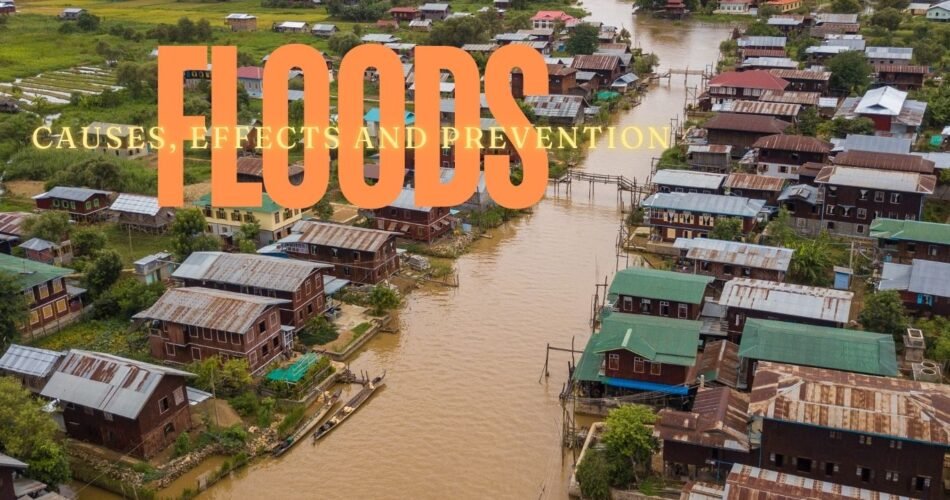This blog provides information about Floods. In the start, it defines Natural disasters. Then it discusses the basic Types of Flood. It also elaborates the main Causes of Floods. Then it explain the potential Effects of Flooding. It also mentions the Prevention Strategies for Floods. In the end, it tells about some Environmental Benefits of Floods. This blog contains Types, Causes, Effects and Prevention of Floods in detail.
What are Natural Disasters:
Natural Disasters are those, that nature drives and most of the time there is no or very little contribution of Humans and artificial systems in it. These disasters cannot be driven completely my humans or any other artificial means. Every year, different natural disasters hit different regions of the world according to their topography, environmental impacts, weather patterns and other environmental aspects. Some examples of Natural Disasters are Floods, Earthquakes, Tsunami, Storm, Tornedo etc. In this blog, we will have a detailed presentation about Floods.
What is Flood?
Flood is the condition in which water from rivers, dams and other water resources overflows and comes on land that is usually dry to destroy vegetation, infrastructure, lives and everything in land. This natural disaster creates a high speed flow of water that it even abandon the trees, houses, shops and all types of human made and natural infrastructure. Every year, floods become the reason of too much infrastructure destruction, life loss and economic loss at great levels. We will discuss the Causes, Effects and Prevention of Floods along with its types.
Types of Floods:
Following are the five Basic Types of Floods:
1. Flash Floods:
These floods are called flash floods because of their fast flow. Flash floods are those which have a drastically fast flow that sweep all the things that are in its path. This is very destructive flood and it damages the infrastructure, lives, cause injuries and destroy everything in its way within minutes. They are so fast in flow.
2. Coastal Floods:
As mentioned in their name, these are the floods that are because of strong winds and surges in the coastal areas. They mostly occur during the high tides in the sea or ocean. If the flood barriers are not completely established, these may cause much damage to the buildings and houses near the cost. As they are in the form of high tides, so they are with pressure and are destructive in nature.
3. River Floods:
These floods originates from the riverbanks. This happens when there is an extended period of heavy rainfall in the area near the river and the river overflows due to excessive amount of water. In this condition the water comes out of the river banks and flows through the cities and villages alongside the river and may cause sudden life loss and infrastructure damage.
4. Urban Floods:
These are the flood because of management failure of a city. It occurs when the drainage system of a city fails to control or accommodate the rain water because of heavy rain for a long time period. This can be in any city and even developed cities of the world have sometimes failed to control urban flooding. This cause transportation related issues, blockage of the roads because of water, rainwater enters into the buildings and shopping malls etc.
5. Pluvial Floods:
This kind of floods are occurred at flat surfaces. It is the conditions where terrains cannot absorb water and the rainwater appears and stays in the form of puddles and ponds. They are very similar to urban flooding but they mostly occurs in rural areas in muddy surfaces. It disturbs agricultural practices and properties of the soil at a great extent. These floods are threatening for fertile soil.
These were the basic Types of Floods. This blog contains Types, Causes, Effects and Prevention of Floods in detail.

Major Causes of Floods:
Following are the major causes of Floods:
Heavy Rainfall Periods:
As we know, floods are overflow of water. Primary cause of Flood is extended periods of heavy rainfall in the same region. Eventually water resources overflows and damage the land areas near those resources causing floods.
Poor Drainage Systems:
Inefficient and inappropriate drainage systems are also a major cause of flooding, especially urban flooding. When the water stands on the roads and the drainage systems are filled, then there are more chances of flooding in nearby areas.
Construction on River Routes:
Most of the people living in the region near the routes of river, construct their houses and shops illegally in the river route. This cause serious danger to their lives and infrastructure. As the river overflows, they are at first effected by the flood.
Deforestation:
By cutting the forests, we are allowing the flood to enter in our cities and villages and cause destruction. Deforestation provide more way to the flood water and reduction in the flood barrier automatically. We can use trees to avoid Flooding.
Rapid Melting of Snow:
When the temperature rises on global level, the heat of the sun cause the glaciers to melt down on exponential rates. These melted glaciers adds to the river through water falls in high pressure and speed. This can be a great cause of flooding in mountainous regions.
Dam Failure:
Dams stores million tons of water in order to produce energy or to store rainwater. If the dam have some malfunction or system failure, it can cause a dangerous flood. It can be drastic, high speed and can destroy all the cities near the dam.
These are few causes of Flooding. Other causes are climate change, soil moisture, Coastal storms, Tsunami and many more.
Effects of Floods:
Following are the effects of Floods:
Life loss:
The most tragic and bad effect of flood is, life loss. Many people die every year during the rescue of flood victims, due to extreme weather conditions, due to lack of management during flood, and lack of shelter for flood victims.
Injuries:
Many people get injuries due to damage caused by floods. Many rescue teams and volunteers get injuries and bruises while helping flood victims and being a flood victim. People suffer a lot during flood and most of the time they do not get proper medical help.
Destruction of Crops:
As the flood water flows with high rates, it destroys the crops. There is no way to save the crops from the flood. Many people lose their efforts of one year in few minutes because of floods. We should avoid cropping in the river routes to avoid damage.
Infrastructure loss:
There is a high economic loss when commercial markets, houses and buildings get destroyed by flood. This infrastructure loss cause many of the people to lose their houses, way of income, commercial goods and many more things important to survive. It takes a long time to recover the losses.
Diseases and Contamination:
Flood water takes a lot of germs and infection with it. Because standing water is not good for human and animal health. Along with the infections and diseases, the flood water contaminates the water and food of the flood victims and cause diseases such as Typhoid, Cholera etc.
Destroy Wildlife:
The floods plays a great role in destroying the habitats of thousands of wildlife animals and plants. Wildlife may be destroyed along with their habitat or the animals may migrate to other places and live in open environment. This condition enhances the risks of hazards for them.
These are few effects of Floods. Other effects include water contamination, soil erosion, mental health impacts, property damage etc. This blog contains Types, Causes, Effects and Prevention of Floods.
Prevention Strategies for Floods:
Following are the prevention strategies of Floods:
i. Establish proper Flood Barriers:
The most important to prevent and control floods, is to establish flood barriers. Flood barriers stops floods of minor levels and reduce the damage during major levels floods. These barriers are essential for river banks, coastal areas and other location where there is a risk of Flood.
ii. Improve Drainage Systems:
Many of the floods are caused because of failure of drainage systems. This is because the drainage systems cannot withstand with heavy rainfall for extended periods. The water stays on the roads and streets and cause urban flooding and it also takes a part in Pluvial, River and Flash Floods.
iii. Early Warnings:
Science has given us some important instruments that can predict upcoming disasters either natural or artificial. Although predictions about natural disasters are not 100% correct every time. But sometimes they are accurate and early planning and warnings can be done to the places at risk of flooding.
iv. Mitigation Measures:
When a prediction is given about any natural disaster, people should be informed about it. Mitigation is actually preparedness about any upcoming problem. When we prepare for the disaster, the damage and destruction is reduced till the disaster hits. It includes migration or people and goods from the areas at risk of flooding.
v. Ban of Construction on River Routes:
There should be legal action on the construction on river routes. The floods that caused extreme damage would have been harmless without the illegal construction. River soil is fertile so people grow crops in that area and live there. We should inform the drawbacks of living there before any damage.
vi. Rainwater Harvesting:
Rainwater harvesting can help in preventing floods at a great extent. If the rainwater starts getting harvested on city level, society level and community level, there will be a better distribution and utilization of rain water and it will reduce the risks of Urban, Pluvial, Coastal and River Flooding.
vii. Education and Awareness:
People of rural areas and urban areas have no knowledge about floods and their preventions. We should organize community based workshops and seminars to aware the people about bad impacts of floods and educate them about the prevention strategies of flood so by educating people, every citizen can help in preventing floods using different ways and little efforts.
These are few Prevention Strategies for flooding.
Environmental Benefits of Floods:
Amazingly there are some environmental benefits of floods. On one hand floods are destruction for humans and other the other hand they are environmentally beneficial. Following are the environmental benefits of Floods:
- Floods help in the reach of water in areas above and below the ground.
- Floods makes the soil fertile by grabbing all the essential nutrients from the river route.
- The water can be stored and utilized by the people of water scarce areas.
- River water supports biodiversity and Farming at a great extent.
- Floods replenish or re-establish the channels of irrigation. This is great for future vegetation and farming practices.
These are the few environmental benefits of Floods. Other than these, floods spread and created sympathy between people of different classes, living standards and regions.
This blog contains Causes, Effects and Prevention of Floods.

To learn about more topics, Click the link below:


Comments